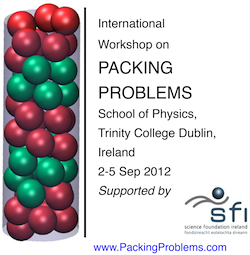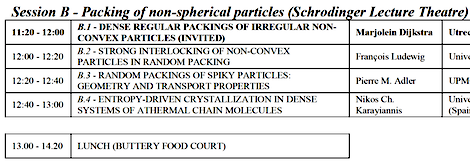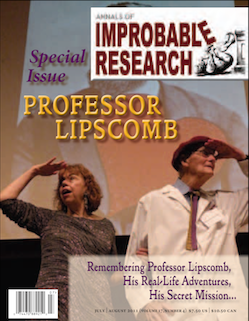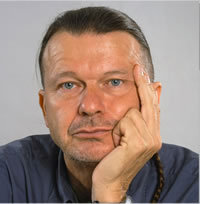Marc Abrahams's Blog, page 546
September 23, 2012
The International Workshop on Packing
 Make your travel plans now for the next International Workshop on Packing. This year’s, held in Dublin in a “packed house”, has just concluded, the participants (all of whom have intriguingly packed schedules) efficiently stuffing their travel accoutrements and dirty clothes into backpacks and suitcases, and hastening back to their labs and homes. The conference’s promoters described the entire affair using some (for once!) unsexy language:
Make your travel plans now for the next International Workshop on Packing. This year’s, held in Dublin in a “packed house”, has just concluded, the participants (all of whom have intriguingly packed schedules) efficiently stuffing their travel accoutrements and dirty clothes into backpacks and suitcases, and hastening back to their labs and homes. The conference’s promoters described the entire affair using some (for once!) unsexy language:
Particular questions to be addressed include:
- What are the best measures to characterize complex packing morphologies?
- What is the link between dense/loose packing and mechanical stability?
- What is the role of topological rules and constraints in packing problems?
- What are the open problems in packing platonic solids?
Speakers will also consider questions of disorder and statistics, which often involve heavy computation. It will also be of interest to those working in High Performance Computing and in Visualisation, and will include an introduction to TCD’s Visualization facilities. The workshop will admit some related problems of space filling or partition (such as the Kelvin problem).
A glance at the conference program shows that one of the delicious highlights was lunch in the Buttery Food Court:

One of the gossiped-about doings at the workshop was the revelation that (as New Scientist magazine later described it) “Spheres waste the most space of any shape if you are packing identical objects into a box.”
The conference web site discreetly refrains from mentioning when or where the next International Workshop on Packing, if there is one, will unfold. This lack of info may put a crimp into your plans, but please do or don’t let it discourage you from seeking more knowledge about packing.
(Thanks to investigator Roger Highfield for bringing this to our attention.)

September 22, 2012
BONE WARS: The Game of Ruthless Paleontology
Love dinosaurs, or love the men who loved dinosaurs too well, or love games, or love a good fight, or love history? If you love any of those things, you may be predisposed to enjoy the game called Bone Wars. Here is the description given by the game’s inventors:
BONE WARS: The Game of Ruthless Paleontology
In BONE WARS, players take the role of paleontologists during the great “Dinosaur Rush” of the late 19th Century.
Out in the field, fossil hunters must survive natural disasters and attempts by other players to steal and destroy dinosaur bones.
Back at the museum, the conflict continues when the scientists carry their battle to the newspapers and scientific journals as they race to achieve scientific immortality!
Most of the wild events in BONE WARS are based on things which actually happened. Edward Drinker Cope really did mount a elasmosaur’s head on the wrong end of the skeleton, and then tried to buy up and destroy all the copies of the journal describing it. O. C. Marsh really did use his personal fortune to hire away all the best fossil collectors from rivals. And the indestructible Charles Sternberg had to outrun flash floods in western canyons. For a time the personal feud between Cope and Marsh involved everyone from the U.S. Geological Survey to the editors of the New York Herald.
BONE WARS is a fast-paced game for 2 to 4 players ages 10 and up.
Each BONE WARS set contains 4 Paleontologist cards, 33 dinosaur bone cards, and 71 Event cards. Each card features color illustrations by artist Bryant P. Johnson.
BONE WARS was created by our team of biologist Diane A. Kelly and game designer James L. Cambias.
BONUS: “Edward D. Cope, Heads Above the Rest, the First Electronic Publisher in Science”
BONUS: Dr. Kelly studies penises.
BONUS: Dr. Kelly helped found the University of Chicago’s scavenger hunt.

The Ig Informal Lectures at MIT — Today!
The Ig Informal Lectures happen today at MIT, in room 10-250 [translation for non-MIT individuals: Building 10, Room 250. The street address is 77 Massachusetts Avenue, Cambridge, MA.]
Most of the new Ig Nobel Prize winners will try to explain, if they can, what they did and why they did it. There will also be a special musical performance by “KEROMIN”, the Amazing FROGS.
This event is free — but seating is limited, so we advise you get there early.
NOTE: Paper airplanes construction and flight is permitted, should you bring paper in sufficient quantity.

Shoe-related automaton: The Shock of the New
Another clever automaton by Keith Newstead, this one fully fleshed out, about shoemaking, and about other things:

September 20, 2012
Announcing the 2012 Ig Nobel Prize winners
The 2012 Ig Nobel Prize winners were announced and introduced on September 20 at a gala ceremony at Harvard University.
Here’s video of the entire ceremony:

Watch the Ig Nobel Prize Ceremony broadcast live!
The broadcast of the 22nd First Annual Ig Nobel Prize Ceremony will begin at 7:15 PM Eastern Time. The ceremony itself is scheduled to start at 7:30 PM Eastern Time. Watch it below!
Please feel free to tweet/facebook/G+ along with the ceremony, using #IgNobel

Ig Nobel ceremony & webcast tonight!
The 22nd First Annual Ig Nobel Prize ceremony happens tonight! Tickets are sold out.
Watch the live webcast here at www.improbable.com, begins at 7:15 pm US Eastern time. The ceremony proper begins at 7:30 pm.
You can download a high-res, PDF version, if you like.

September 18, 2012
Remembering Professor Lipscomb
 This year’s Ig Nobel Prize Ceremony will be our second since Professor Lipscomb left us. A year ago, Peaco Todd [the image here shows Peaco and Professor Lipscomb together at an earlier Ig ceremony] wrote an essay after attending the memorial service for Professor Lipscomb. It begins:
This year’s Ig Nobel Prize Ceremony will be our second since Professor Lipscomb left us. A year ago, Peaco Todd [the image here shows Peaco and Professor Lipscomb together at an earlier Ig ceremony] wrote an essay after attending the memorial service for Professor Lipscomb. It begins:
Recently I attended a memorial service for someone who had become, for me, both a friend and an inspiration. Dr. William Lipscomb received the 1976 Nobel Prize in chemistry for “studies that were the first to explain the chemistry of the element boron and, in particular, those exotic combinations of boron and hydrogen called boranes” (Thomas H. Maugh II, Los Angeles Times). I knew him as Bill — my special laureate in the annual Ig Nobel Award ceremony where I perform on stage as a “minor domo.”
Bill was, without question, a superb scientist — he won his Nobel Prize alone, not as part of a team, which is quite rare — and a gifted teacher; two of his students went on to win their own Nobels. His musical abilities were notable; he played the clarinet with the skill of a professional. Above all, Bill was a great humanist and a very wise man. At his memorial service, among the accolades and fond recollections, one story, told by a former graduate student, took me by surprise.
Eric Gouaux talked about his years of studying with “the Colonel,” as Bill, channeling his Kentucky roots, was affectionately known. Gouaux recalled talking with Bill about his decision to study chemistry. Why chemistry? Bill replied that once he decided to follow his science bliss, rather than pursue a career as a clarinetist, he figured he would take up physics. “But then,” Bill said, “I discovered that I couldn’t make mistakes fast enough in physics.”
He couldn’t make mistakes fast enough in physics. But he was able make mistakes fast enough in chemistry, so chemistry it was.
BONUS: A video look at Colonel Lipscomb, then aged about 90, showing off one of his minor skills:

Blobjects – a disambiguation
 According to Wikipedia, a Blobject (n.) is: “… a design product, often a household object, distinguished by smooth flowing curves, bright colors, and an absence of sharp edges.” But for philosophers (ontologists in particular), a Blobject can be more, much more, than that … “Imagine a world consisting entirely of gunkish, jello-ish, stuff.” viz., the whole universe ‘The Blobject’. And thus in turn, inevitably perhaps, the concept of the Blobject gives rise to a broad philosophical field called Blobjectivism. The implications are pinned down (as best as they can be for a Blobject) in a year-2000 paper by Professor Terry Horgan (University of Arizona, US) and Professor Matjaž Potrč (University of Ljubljana, Slovenia) ‘Blobjectivism and Indirect Correspondence ‘ (for the journal Facta Philosophica, 2, pp. 249-70). The professors not only lay out the case for Blobjectivism, but also extend the examination of their hypothetical Jello-World by considering lumps, congealings, events and boundarylessness. [their underlining]
According to Wikipedia, a Blobject (n.) is: “… a design product, often a household object, distinguished by smooth flowing curves, bright colors, and an absence of sharp edges.” But for philosophers (ontologists in particular), a Blobject can be more, much more, than that … “Imagine a world consisting entirely of gunkish, jello-ish, stuff.” viz., the whole universe ‘The Blobject’. And thus in turn, inevitably perhaps, the concept of the Blobject gives rise to a broad philosophical field called Blobjectivism. The implications are pinned down (as best as they can be for a Blobject) in a year-2000 paper by Professor Terry Horgan (University of Arizona, US) and Professor Matjaž Potrč (University of Ljubljana, Slovenia) ‘Blobjectivism and Indirect Correspondence ‘ (for the journal Facta Philosophica, 2, pp. 249-70). The professors not only lay out the case for Blobjectivism, but also extend the examination of their hypothetical Jello-World by considering lumps, congealings, events and boundarylessness. [their underlining]

September 17, 2012
The scientist who ate 100 ants, repeatedly
There once was a man who swallowed some ants.
‘Twas done with intent, not merely from chance.
The ants were alive,
But did not survive.
The research was done without government grants.
 The man was and is Volker Sommer, [pictured here] professor of evolutionary anthropology at University College London. He and colleagues Oliver Allon and Alejandra Pascual-Garrido travelled to Nigeria’s Gashaka Gumti national park. There, chimpanzees and army ants and sticks are plentiful – the former use the latter to dip into nests for presumably delicious helpings of fresh, lively army ants of the species Dorylus rubellus. As the scientists describe it: “Army ants respond to predatory chimpanzees in a particular way by streaming to the surface to defend their colony through painful bites. In response, chimpanzees typically harvest army ants with stick tools, thereby minimising the bites they receive.”
The man was and is Volker Sommer, [pictured here] professor of evolutionary anthropology at University College London. He and colleagues Oliver Allon and Alejandra Pascual-Garrido travelled to Nigeria’s Gashaka Gumti national park. There, chimpanzees and army ants and sticks are plentiful – the former use the latter to dip into nests for presumably delicious helpings of fresh, lively army ants of the species Dorylus rubellus. As the scientists describe it: “Army ants respond to predatory chimpanzees in a particular way by streaming to the surface to defend their colony through painful bites. In response, chimpanzees typically harvest army ants with stick tools, thereby minimising the bites they receive.”
The team craved more knowledge about this chimp/ant give-and-take. So they “mimicked the predatory behaviour of tool-using chimpanzees at army ant nests to study the insects’ response”….
So begins this week’s Improbable Research column in The Guardian.

Marc Abrahams's Blog
- Marc Abrahams's profile
- 14 followers
























